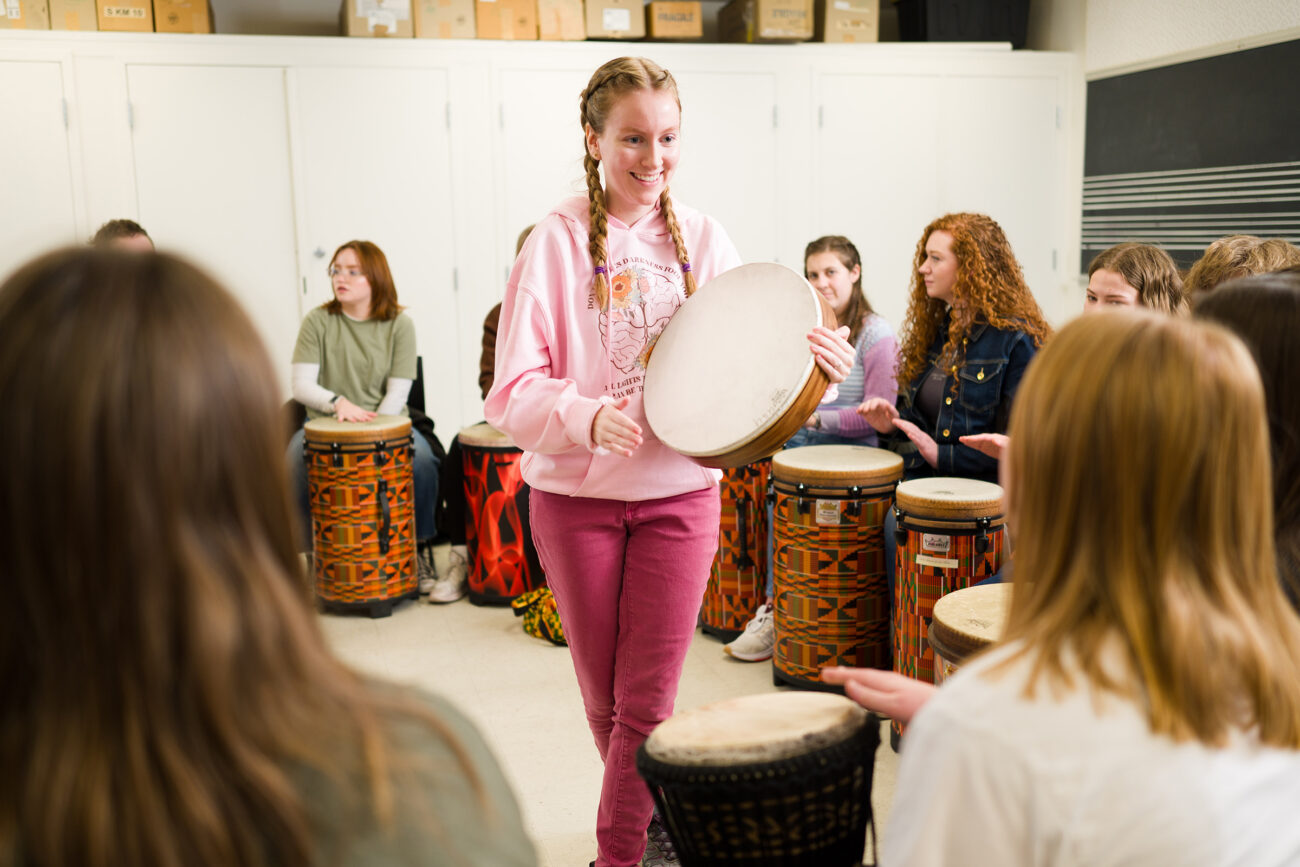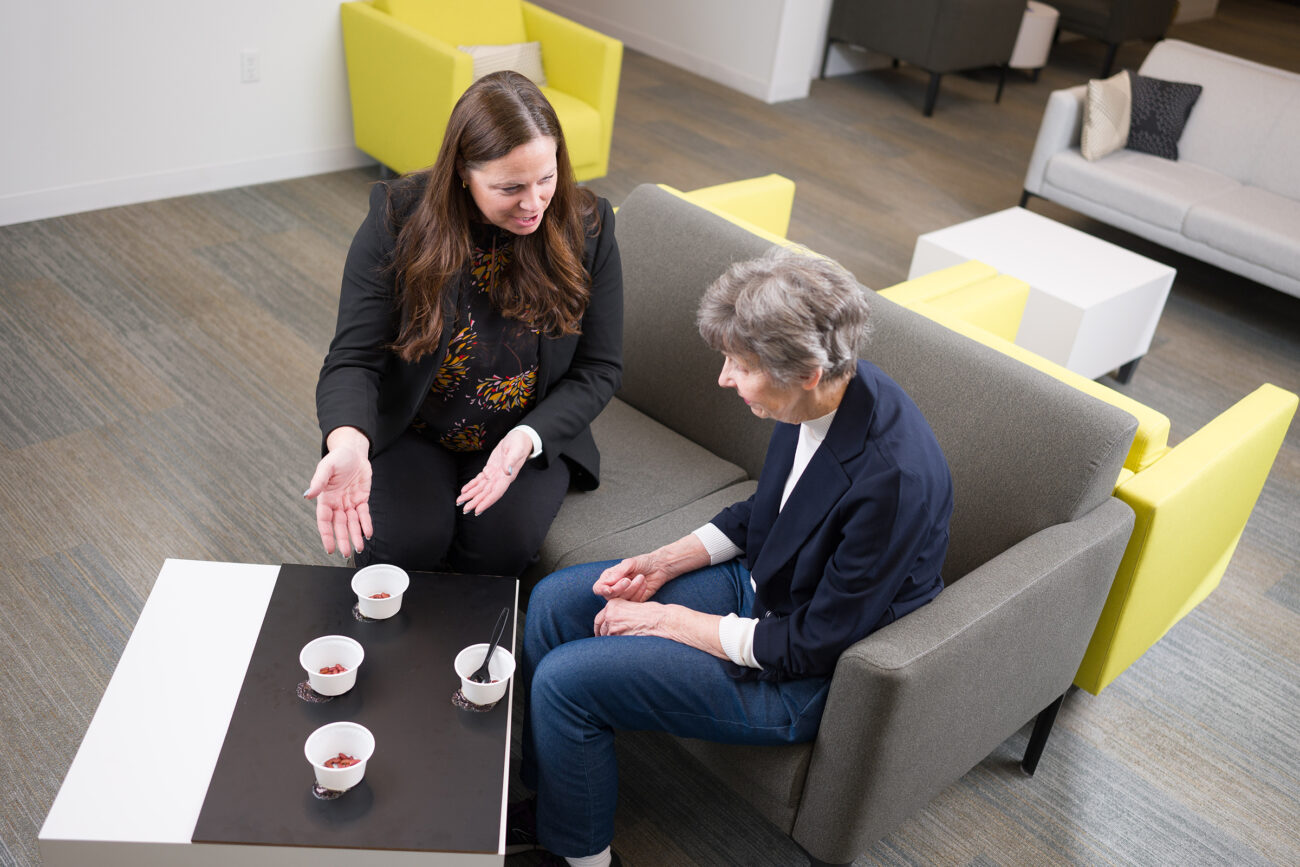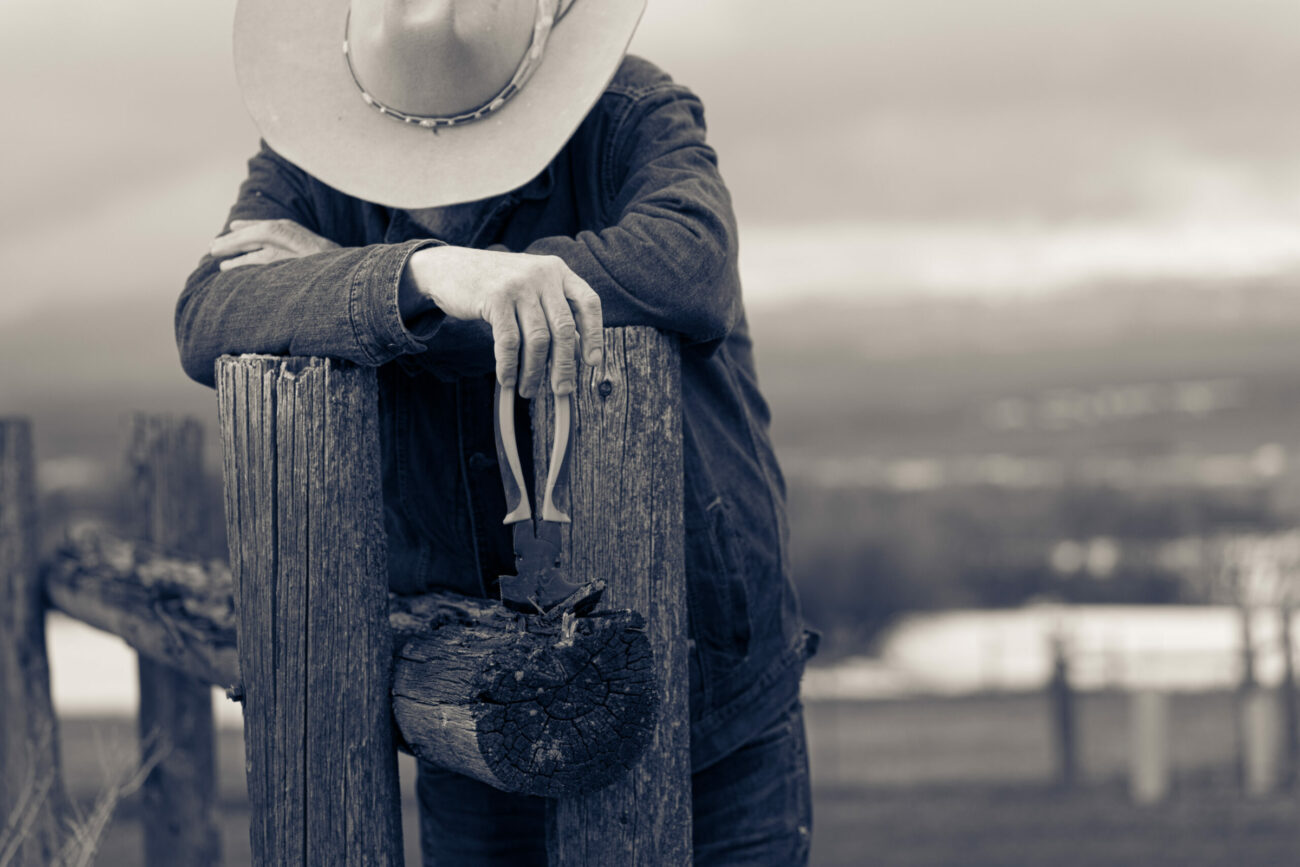Gleaning Up: Student-led Group Gathers Produce for Those in Need
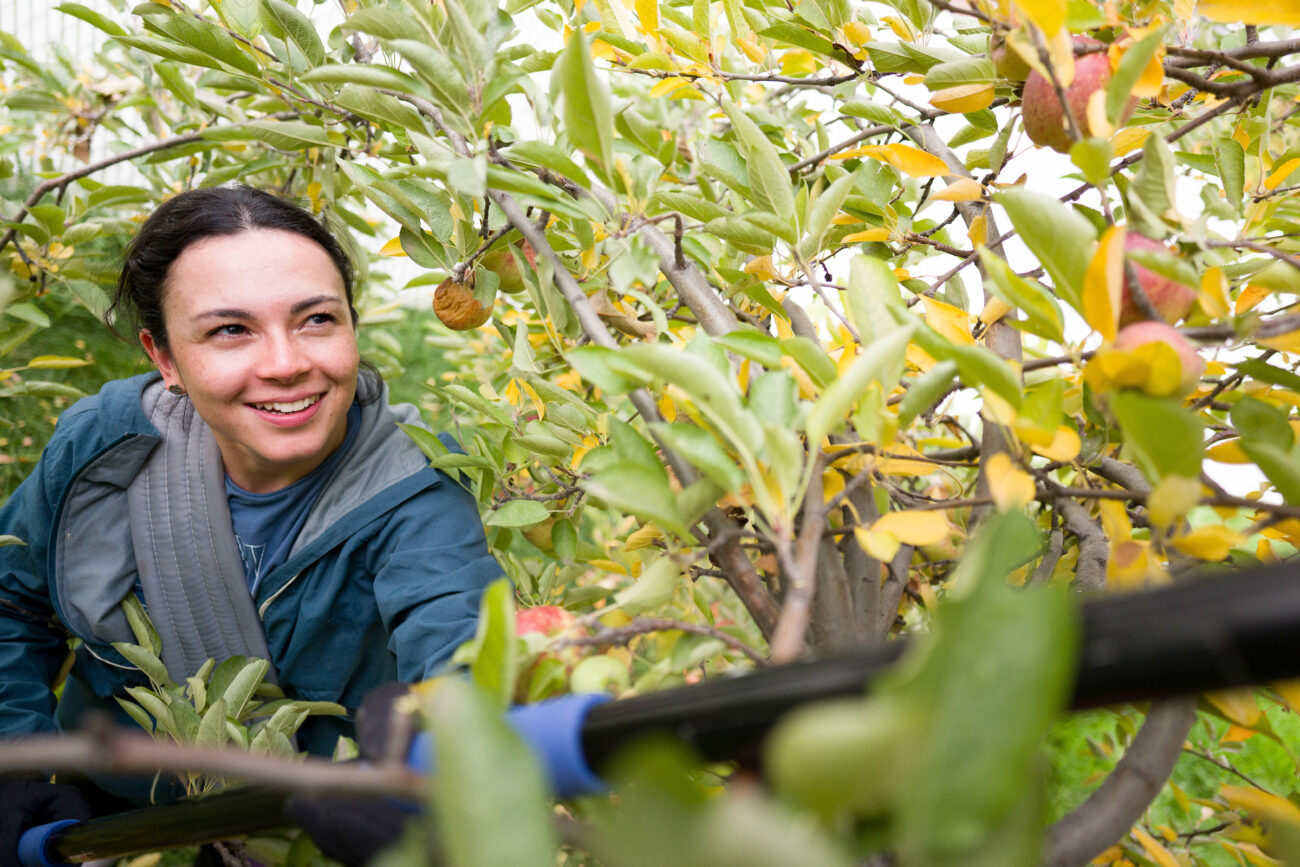
By gathering food that would otherwise go to waste, the USU Gleaning Team is working to reduce food waste and increase food security
By Jeff Hunter ’96
Time is running out.
There’s less than a week left in October, which means colder, more unsettled weather in Cache Valley. And on this Wednesday afternoon, the sky is gray, the wind is blowing, and the 65-degree temperature is rather misleading.
A cold front is closing in on northern Utah, and tomorrow’s forecast calls for rain in the valley, snow in the mountains, and a hard freeze Thursday night/Friday morning after the storm has cleared out. That means the produce harvesting season that began back in early July is rapidly ending for the USU Gleaning Team, leaving this session at a residence in the Logan suburb of Nibley as likely the final one of 2023.
A student-run program based out of the Christensen Office of Social Action and Sustainability (COSAS), the USU Gleaning Team organizes volunteer labor to harvest fruit and vegetables in Cache Valley. That produce is then distributed to individuals dealing with food insecurity via the Student Nutrition Access Center (SNAC), as well as community entities like the Cache Community Food Pantry, Cache County Senior Center, and the Loaves and Fishes Community Meal.
Less than a week earlier, team lead Kate Markman and COSAS helped accommodate more than 30 volunteers looking to support USU’s annual Legacy of Val Day of Service event, leading to the collection of more than 5,000 apples and pears that otherwise would have gone to waste.
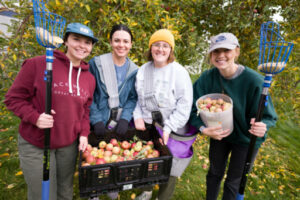
Today’s session in Nibley is a much more intimate affair, with Markman, assistant team lead Kimmy Curtis and a couple of volunteers working on a piece of property. Owned by a former Utah State University employee, the large backyard boasts five apple trees and a plum tree. Curtis, a senior from Salt Lake City, is the first to arrive, pulling up on the street in a white full-size Ford pickup, a rental from the USU motor pool loaded with equipment. The tools of the trade include numerous plastic crates, a ladder and several fruit pickers, extendable poles tipped with wire baskets, all tucked into a collapsible wagon.
“I volunteered a few times last year, then I started in this position in June. So, I’ve probably been to about 20 sessions altogether,” says Curtis, dressed for the occasion in a green camp hat, maroon hoodie, Carhartt pants, and black Chuck Taylor All-Stars.
“I definitely like being able to help members of the community with food security while saving food. But I was also looking for ways to get out in nature more and be more active because with school you can get stuck inside just doing the same things over and over again.”
While Curtis is busy unpacking the equipment, the two volunteers arrive. Kallie Hull has been to a gleaning session before, but Joan Millward is a rookie currently taking a course in nutrition science. Curtis provides a little bit of instruction, most of it around ladder safety, and about grading the fruit: the best apples are handed out to be eaten, while those with significant imperfections will be pressed into cider or turned into applesauce or fruit leather.
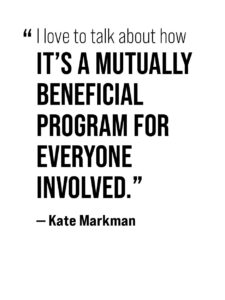
“Basically, our goal is to reduce food waste and increase food security,” Curtis explains. “And we do that through helping people in the community, as well as property owners with extra produce. So, every time you help us it’s helping increase food security. And for every one person who volunteers, the session results in about 100 pounds of fruit.”
Soon, all three women converge on the closest tree, where they share their names and fields of study with each other as they quickly fill up several crates with just the lowest, most easily accessible apples. The ladder and picking poles will come later.
“I’m seeing a lot of little ones; you can just can go for the big ones,” Curtis instructs as she looks over a branch heavily laden with apples.
Curtis then notes that “quality control” is also part of the job.
“So, we can also have a little snack, which is good because I didn’t have dinner,” she adds with a big smile as she plucks an apple from a tree and picks out the best spot for her first bite.
A Mutually Beneficial Program
Kate Markman is the sustainable food lead in the Christensen Office of Social Action and Sustainability. The senior from Riverton first became involved with the gleaning team in May 2022, and she’ll be graduating in May 2024 with degrees in art and sociology. In between, she’s worked plots of land throughout Cache Valley, harvesting surplus produce in all kinds of weather.
“I was at a point in my college career where I felt like I was really settled into academics and was looking for a place where I could get more involved in the student community and was looking for service opportunities,” says Markman of her initial experience with the COSAS office. “I went to an information meeting about volunteering at the SNAC, but some interns who were running the gleaning team started talking about the program and that they were looking for a new lead.
“I had never done anything like it before, but it sounded interesting to me.”
Former USU student Kara Bachman started the gleaning program in 2019 shortly after witnessing a similar team in action while volunteering during an Alternative Break experience in Arizona. The program, which was originally known as the Cache Community Gleaning Team, was recently rebranded as the USU Gleaning Team to make it more identifiable as a student-led project.
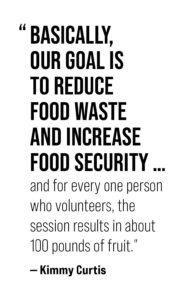
“(Bachman) volunteered with a gleaning team while she was in Arizona and realized that we had a similar need for produce at the SNAC and other food pantries up here,” Markman says. “She also noticed that there were a lot of fruit trees in the valley that had fruit that was just falling off and rotting. So, she decided to start something here modeled in a similar way as a way of saving good produce that existed in our community.”
The gleaning team’s largest crop each year is apples, but they also collect pears, apricots, peaches, and cherries, as well as vegetables like tomatoes, squash, corn, and green beans.
“It ebbs and flows and depends on what the individual crops look like each season,” Markman notes. “But apples are definitely the most reliable. Every year we can count on thousands of pounds of apples.”
Although there’s no specific parameters, the team usually works properties in Cache Valley between Smithfield to the north and Hyrum to the south. The team makes sign-up sheets available online for volunteers, and Markman coordinates the dates of the sessions with the property owners, many of them whom have now been involved for several years.
“I love to talk about how it’s a mutually beneficial program for everyone involved,” Markman points out. “It saves the property owners some cleanup, and many of them have said it’s a very fulfilling feeling knowing that their produce is being enjoyed by people who really need it. And it’s beneficial for the community partners because they don’t have to source as much of their produce, and the volunteers who help us pick can take as much of the produce home as they want.”
Making an Impact
Hull is bringing some experience to the final gleaning event of the season in Nibley.
While working in the Sustainability office in 2022, Hull says she was involved in the thrift shop and farmers’ market, and attended at least a half-dozen sessions in support of the gleaning team. However, a job in Alaska kept her away last summer, so the final gathering in Nibley came at just the right time.
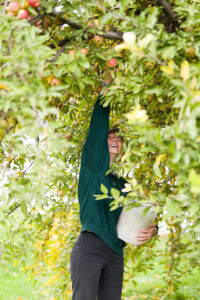
“I’ve been really busy with school, but this week, I really needed something to distract me,” Hull says while sitting on the grass and pulling apples out of one plastic crate, quickly looking them over and determining the quality before putting them in different crate.
A senior from Clearfield studying environmental science, the former AmeriCorps volunteer says she enjoys gleaning duty because it’s a “really good opportunity to be sociable and meet people with similar interests.”
“I’ve also helped out in the SNAC a little bit, and it’s all just a fun way to get involved in the community and do something that benefits other people,” she adds.
That’s exactly what Curtis says she tries her best to impart in those who sign up for a session with the USU Gleaning Team for the first time. While the work may take place on a hot, dry day in July, a rainy, muddy day in August, or a sunless day in October, the service they furnish to help provide food security for their fellow students and community members is extremely meaningful.
“When we have new volunteers, I always try and gauge how much they know about the program, and let them know why they’re here, why it matters, and who it impacts,” Curtis explains. “I try to bring it into like a small-scale reality of how it’s not just some random service project and tell them why it’s so important.”



